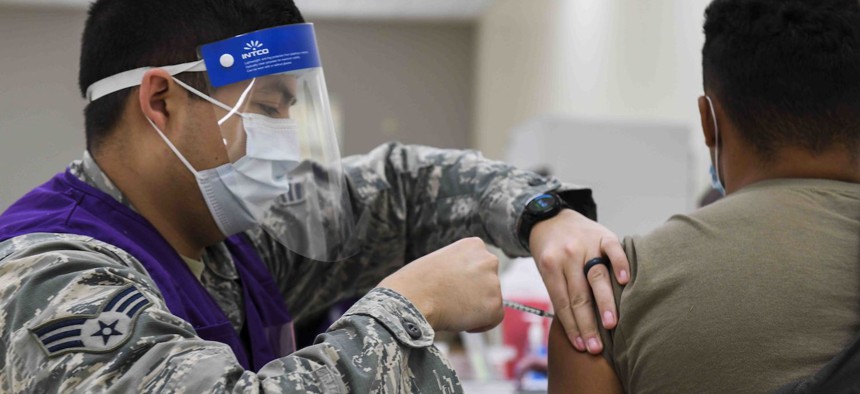White House Aims for Bio-Defense ‘Moonshots’ In New Strategy

A U.S. Air Force pilot receives the COVID-19 vaccine at Fairchild Air Force Base, Washington, Jan. 21, 2021. The Biden administration has announced a strategy that, among other goals, aims to bring the timeline for developing new vaccines down to 100 days. U.S. Air Force / Airman 1st Class Kiaundra Miller
Biden wants more rapid testing, vaccine production, etc. using breakthrough technologies.
The Biden administration on Tuesday announced a new biodefense strategy intended to help protect the United States from future biological threats and mitigate the effects of pandemics and communicable diseases.
As part of that strategy, the administration is requesting $88 billion in pandemic preparedness over the course of the next five years, in part to fund new research to predict outbreaks before they become pandemics, accelerate rapid testing to get ahead of where viruses are moving, and to bring the timeline for developing vaccines down to three months.
Some of the strategy’s goals include things like detecting the spread of pathogens before patients even begin to show symptoms like fever, developing a way to easily diagnose new pathogens within 12 hours of an outbreak, and scaling up the number of diagnostic tests kits by tens of thousands within a week and rapid tests within 90 days. One particularly lofty goal is to be able to develop a new vaccine in 100 days, and to have enough for the entire U.S. population after 130 days.
A senior administration official speaking to reporters before the announcement described it as a series of “moonshots” and acknowledged that “the science and technology goals layout timelines that are not possible today, but these capabilities can be achieved and are within our reach with the right resources over the next five to 10 years.”
Meeting some of those targets will require scaling up data collection efforts at research facilities around the globe.
The ability to monitor a small outbreak before it becomes a pandemic would require pathogen researchers to collect and structure massive amounts of data on emerging pathogens, particularly in birds, to predict the leap to humans as well as further mutations. New approaches to RNA research could deliver therapeutic aids (that boost antibodies) to ease pandemics in a fraction of the time it takes to create a vaccine that meets FDA emergency use criteria. And new forms of plant-based vaccines could also allow for the scaling up of vaccine production by orders of magnitude. The administration official did not specify exactly what technologies they will invest in to meet the strategy’s goals.
But while it is technically feasible to reach these goals, the government has had a hard time meeting even mundane needs related to pandemics, such as having enough protective gear on hand for healthcare workers. In addition to funding new science and technology, the strategy also seeks to ensure the government is “not stuck with just a few [protective gear] providers, that we have a steady state and market supply, that we have the ability to manufacture surge capacity … that we have storage and inventory capacity.”
The strategy also aims to boost the number of local healthcare workers—including lab technicians, epidemiologists, veterinarians, and community-based health workers—in all 50 states.
But with an estimated shortage of 29,400 nurse practitioners by 2025 and shortages of other healthcare workers looming, it’s not clear how the government can overcome current trends.
The senior official said bringing in more traditional frontline healthcare workers is a key focus, but many of the positions the strategy seeks will be related to research and data collection. That will require expanding the CDC’s epidemiology field officer program, bringing more epidemiologists to every state, and “trying to ensure we expand state public health veterinarians and staff in all 50 states and then, you know, really trying to see if we can do better on this front going forward.”






